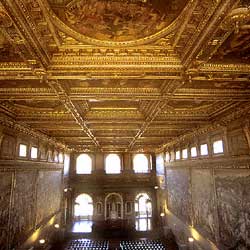|  The
foundations of the palace designed by Arnolfo di Cambio were laid in February
1299. The main facade and the 94-metre tower had already been completed
by 1302, but the rear of the building was constructed and amplified in
various periods through to the final modifications made by Ammannati in
1588. It was originally conceived of as the residence and offices of the
Priori and the Gonfaloniere di Giustizia, who were commonly called "Signori".
They held office for two months during which time they were obliged to
live prevalently in the palace following severe rules similar to those
of a convent community. The
foundations of the palace designed by Arnolfo di Cambio were laid in February
1299. The main facade and the 94-metre tower had already been completed
by 1302, but the rear of the building was constructed and amplified in
various periods through to the final modifications made by Ammannati in
1588. It was originally conceived of as the residence and offices of the
Priori and the Gonfaloniere di Giustizia, who were commonly called "Signori".
They held office for two months during which time they were obliged to
live prevalently in the palace following severe rules similar to those
of a convent community.
The name of this palace has changed names a number of times; initially
known as the "Palatium Populi" ("Palagio" in spoken
language), it was later called the "Palazzo della Signoria".
In 1540 it was renamed "Palazzo Ducale" when Duke Cosimo I took
power, and only later did it become known as "Palazzo Vecchio".
When Firenze was the capital of Italy from 1865 to 1871, it was the seat
of the Parliament.
There have been few changes to the exterior over the last seven centuries,
but the interior has changed appearance a number of times. At the end
of the 1400s, when Savonarola was in power, he had the famous Salone dei
Cinquecento built where the 500-hundred strong people's council could
meet to deliberate. Later, under the rule of Cosimo I, Vasari transformed
it in honour of his rise to power with frescoes of the Florentine victories
over other Tuscan cities. In 1454, Michelozzo rebuilt the austere medieval
courtyard of the palace in the style of the early Renaissance. A hundred
years later, Vasari embellished it with gilded stuccoes and frescoes with
images of the principal cities of the Habsburg empire in honour of Giovanna
of Austria, wife of Francesco De' Medici. At the centre of the courtyard
there is a small fountain, the Putto with Dolphin (now a copy) by Verrocchio,
positioned on a porphyry basin by Francesco Ferrucci. Around about 1550,
Duke Cosimo came to live in the palace together with his family and had
it altered to suit his needs by Vasari, who created meeting rooms and
family apartments and engaged numerous artists of the age to assist him.
Only some of the artistic treasures of Palazzo Vecchio can be described
here. Besides the Salone dei Cinquecento, there is the Studiolo di Francesco
I, an extremely atmospheric room shaped like a Florentine chest, without
windows and entirely frescoed by various artists. Francesco spent a great
deal of time here immersed in his scientific studies. The Sala dei Gigli,
with a beautiful entrance portal and a coffered ceiling, was the work
of Benedetto and Giuliano da Maiano; inside there is the original of the
Donatello bronze entitled Judith and Holofernes, which was commissioned
by Cosimo il Vecchio. The room is decorated with gold lilies on a sky
blue background (hence the name), which do not refer, as one might imagine,
to the symbol of Firenze, but to the French lilies of the Anjou, protectors
of the Guelph clan.
The Sala delle Udienze, together with the Sala dei Gigli, once formed
a single large room used for meetings of the Priori and for court sessions.
The artist Giuliano da Maiano decorated both the coffered ceiling and
the marble portal with the stem of the Florentine people. The frescoes
in this room were done by Salviati.
Today Palazzo Vecchio is the seat of Firenze City Council and many parts
of it can be visited by the public.
Picture by Sandro Santioli
Translated by Jeremy Carden
|